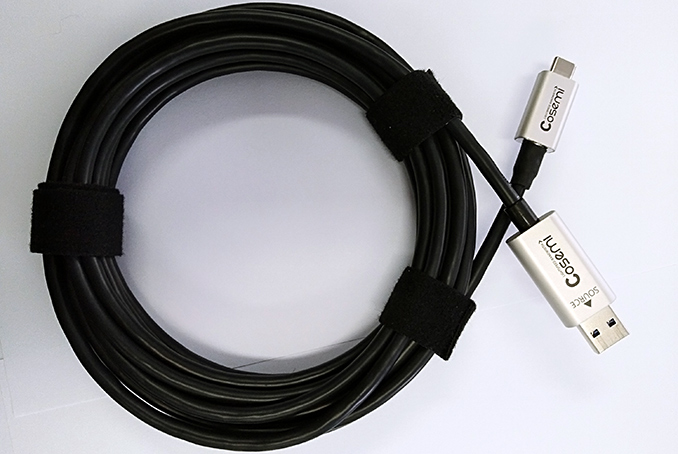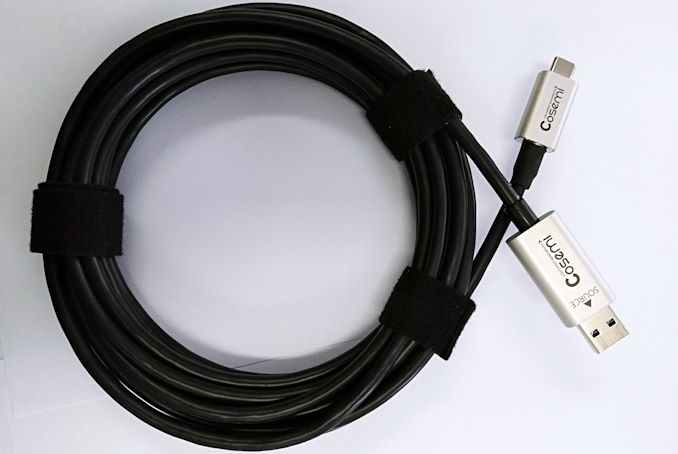Cosemi Launches USB 3.1 Gen 2 Hybrid Active Optical Cable: Up to 50 Meters of USB
by Anton Shilov on February 12, 2019 1:30 PM EST- Posted in
- Peripherals
- USB-C
- Cosemi
- USB

Cosemi has introduced the industry’s first USB 3.1 Gen 2 hybrid active optical cables (hAOC), which enable USB connectivity over distances upwards of 50 meters. The cables will be available with various connectors and therefore will be able to address various applications.
As you might guess from the name, Cosemi’s USB 3.1 Gen 2 hybrid active optical cables use fiber optics for data transfers, which is further paired with copper wires for control and power. The data portion of the cable is fully USB SuperSpeed+ capable, meaning it can transfer 10Gbps in each direction. Notable, since hAOCs can power themselves, unlike other solutions they do not need any extension boxes or repeaters, making them simpler and more reliable. Using fiber for the data channel also means that the cables are more resistant against EM and RF interference, which is particularly important for medical applications.
The manufacturer plans to offer hAOCs with various types of connectors, including USB Type-A to USB Type-A, USB Type-A to USB Type-C, as well as USB Type-C to USB Type-C, with A-to-C cables being the first type out the door. And while the cables are best geared for high bandwidth applications, like copper USB 3.1 Gen 2 cables, the hybrid active optical cables are backwards compatible with the USB 2.0 spec.
Last but not least, it's interesting to note that Cosemi’s hAOCs do not use PVC. As it turns out, this is a requirement for in-wall cables in the Americas, EMEA and Asia, as PVC produces toxic smoke when it burns.
Cosemi’s USB 3.1 Gen 2 hybrid active optical cables are sampling today, and mass production is set to start in March. The devices will be available later this year from various Cosemi’s partners, including Amazon, Liberty AV Solutions, and other. The manufacturer is not setting an MSRP quite yet, but tells us to expect them to be “competitive to USB extension box solutions.”
Related Reading:
Source: Cosemi











39 Comments
View All Comments
BedfordTim - Thursday, February 14, 2019 - link
The issue isn't flexibility but rather that the highly flexible cable breaks if you use a bend radius under about 10cm. It has its use but I would avoid it given the choice.saratoga4 - Wednesday, February 13, 2019 - link
>One major problem is the fragility of fibre. It looks like a wire but the minimum bend radius is much larger.SMF28 has a minimum bend radius of a few millimeters. You can coil it tight around your pinky finger, tighter even than CAT5. The problem isn't bending (it is way more flexible than copper), it is kinking it. Fiber doesn't like being kinked or scratched.
BedfordTim - Thursday, February 14, 2019 - link
You are thinking of single mode fibre. The USB extenders I have come across have used multi-mode which is easier to couple into but has a larger bend radius. Even single mode SMF-28 has a 4cm long term minimum bend radius so if you coil it tight around your pinky finger it will die with time.repoman27 - Wednesday, February 13, 2019 - link
@Sahrin, Light Peak added optical channels to the USB Type-A connector and could leverage the USB VBUS for power. It was never intended to be fully optical. Also, nothing about the protocol was "nerfed". AFAIK, there was literally no change to the host controller silicon. I understand that lasers are cool and all, but for a desktop peripheral interface, optical is not the right choice (unless it's the only choice or silicon photonics become a realistic option). And there was never a competition between Thunderbolt and USB, both of which Intel has a marked interest in. The idea from the start was that they would share the same connector / receptacle, it just took 5 years and the creation of the USB Type-C Cable and Connector Specification to get there.Not including optical transceivers in every device was the only sane way to proceed, and active cables can use either copper or fiber for the high-speed signaling lanes. Corning, Lintes, and Sumitomo Electric all make optical Thunderbolt 1/2 cables, with OWC, Sonnet, and StarTech having offered their own branded versions. Pushing a 5 V (or even 12 V) power bus down 60m of cable is obviously challenging (you'd need larger than 14 AWG conductors), so I'm not sure what Cosemi has done to make these cables comply with the USB spec. However, they have opted to start with a Type-A to Type-C cable, which simplifies things somewhat.
@Anton Shilov, PVC is incredibly common in both CMR and OFCR cable in the US, and I'm pretty sure it's also used / allowed in plenum rated cables as well. So I'm not sure what they're on about with the no PVC thing, unless it's just to meet European LSZH requirements.
teldar - Wednesday, February 13, 2019 - link
Teflon is supposed to be used in true plenum cabling, to my knowledge. PVC should not be used in a plenum wire, to my knowledge. Or at least something that doesn't release the chemicals PVC does. My understanding is that is the point of plenum.MrSpadge - Tuesday, February 12, 2019 - link
If you want higher speed than regular Ethernet and want to go down the costly route of active optical cables, you may as well use them for the faster Ethernet standards. The optical part does not really care about the protocol.c4v3man - Tuesday, February 12, 2019 - link
Found the Apple user...Nobody in the industry would want to use thunderbolt as a whole home networking platform. 10Gbe is available over copper, faster/lower latency standards are available over fiber optic but are ridiculously expensive, but regardless Thunderbolt 3 is an expensive interface that has SUBSTANTIAL benefits when it's excessive cost is justified in light of it's bandwidth and power delivery capabilities. Such as a dock for a laptop/micro PC where 100+ watts of power, and 2x 4K60p displays can be connected over a single cable. It's great that Apple was an early adopter of Intel's interface standard, and it's a shame that more Wintel providers don't use it and instead try to push USB-C as a viable docking standard, but let's be reasonable as to the real-world use cases Thunderbolt was designed for. Whole home networking is not even remotely what Thunderbolt is designed to do.
jeremyshaw - Tuesday, February 12, 2019 - link
IMO, DP-Alt + USB-C PD will be more than enough for most people.Of course, DP-Alt on most Intel laptops is gimped to DP1.2...
eGPU really only benefits users who really want a laptop with a GPU, but cannot actually have a GPU in a laptop. Outside of Apple, small laptops with GPUs are not uncommon. Inside the ~7% marketshare of Apple, choices are extremely limited.
star-affinity - Wednesday, February 13, 2019 - link
So a built-in GPU can compete with a desktop size one in an external case? Seems legit. ;)star-affinity - Wednesday, February 13, 2019 - link
But I agree hardware options in the Apple camp are too limited. Still like that eGPUs are embraced.